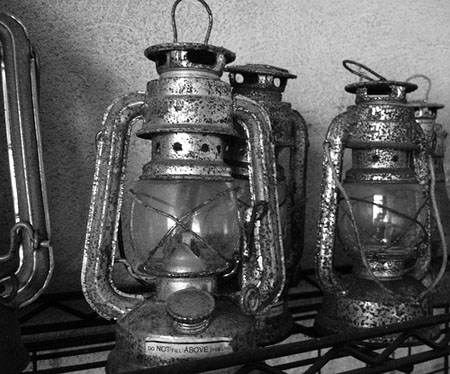Images source: flickr.com
The objects and tools around us are losing their physicality. Our cars, watches, music, phones, adding computers, and now light sources are less analogue and mechanical, as they become more digital and quantum / nano scale. Although these new innovations perform better, faster, and more efficiently, we lose the ability to see and understand how these technology work. Everything operates in a conceptual black box, as we pray that things work when we need them, because we cannot fix them by ourselves even if we were so inclined. Although we can learn conceptually how an digital watch works, we have lost the ability to use physical cues of how things work. This loss may not be earth shattering, but it does eliminate the ability of us to fix things when they break down as well as adapt their inter-workings to conform to our own needs. We are encouraged to throw away and conform.
Light from oil-based lamps and candles once provided the standard way of seeing at night. Even if you didn’t understand the physics of combustion, you could still built a mental model of how it works through experience working with its physical cues. Fire burned fuel to make heat and light. If a lamp wasn’t working, the problem could only be a few possibilities, most likely having to do with fuel and oxygen.
The introduction of the incandescent bulb worked by sending an electric current though a filament in a bulb. Here, the electric charge flowing through the filament also created heat and light. Electricity was a much safer and convenient energy source for lighting the home, an important advance. However, it was a step away from the physicality of our source for light. Even without precise knowledge of the basic science behind the light bulb, if a light bulb wasn’t working, you could still try to figure out the problem, by checking to see if it was the bulb or the power. We know that when bulbs burn out, the filament breaks. Therefore, we shake the bulb to hear if the filament is broken, albeit gently in case it is not broken. The sound of the broken filament is still an excellent feedback mechanism for testing a bulb. The kind of natural feedback that Don Norma discusses in “The Design of Future Things.”
This simple, yet effective method of testing a working bulb is eliminated when we move to the compact fluorescent bulbs and Light Emitting Diodes. On a physics level, light from CFBs and LEDs work on a nano or quantum scale from the macro or classical physics scale. Similarly, the CFBs and LEDs also take us another step away from the physicality of light. Although we still have bulbs or diodes, respectively, the objects themselves give us less natural feedback to what is going on. How do you tell what is happening when a CFB or LED is dead? I have no idea. CFBs and LEDs are cheaper, more energy efficient and last much longer than incandescent bulbs, which makes the gains in trade off preferred to the status quo.
In the end, I’m left wondering what is the value of this physicality? How important is it for people to have physical models of how their objects work? Am I just being nostalgic for the past or is there something greater at stake?





You might find some analogous thinking in an online article at The Atlantic called Is Google Making Us Stupid? http://www.theatlantic.com/doc/200807/google
Because you worked on a “future of the book” project this should particularly interest you. I found myself captured by the story of Friedrich Nietzsche and his typewriter.
Hello.
Yes, that is great article, and there have been a lot of good blog reactions to it. Have been meaning to put down some ideas on it… maybe your comment will prod me a little bit.
Thanks!